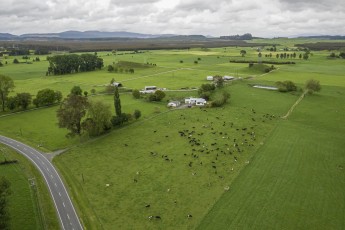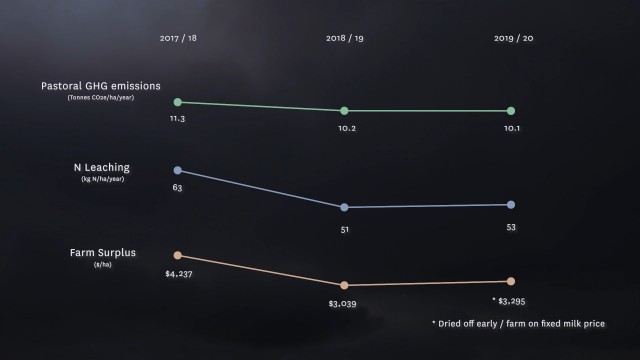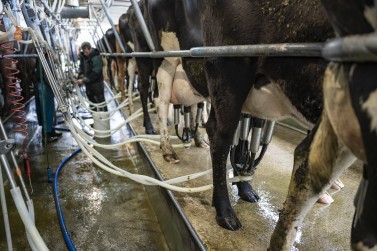George and Sharon Moss, Waikato
George and Sharon Moss have been dairy farming in Tokoroa for nearly 40 years. Their impact on the climate wasn't a consideration back then, but it's at the forefront of how they farm now. They have moved from purely profit-focused, to seeking the sweet spot of people, planet and profit.
About the farm
The Mosses operate adjacent dairy farms just north of the Kinleith pulp and paper mill in south Waikato. Pukerua Farm is 70 hectares effective, milking 170 pedigree Friesians and Tokoroa Pastoral Farm is 67ha effective, milking 173 crossbred cows. They also own an adjoining 40ha drystock block.

The Mosses dairy farm in Tokoroa (Photo: Dave Allen Photography)
The farm soils are Tāupo pumice and the average annual rainfall is 1,500mm. There aren’t any major waterways crossing the farms and being on flat land, there are no issues with erosion.
Both herds are managed as System 2, grazed on their respective farms with a small amount of feed brought in when required. During winter, cows are stood off on yards and adjacent quarry areas when needed.
Over time, stocking rates have been gradually reduced to match demand more closely with supply of homegrown feed. This has helped reduce nitrogen leaching. The reduction in stocking rates mean both farms are now stocked at around 2.5 cows per hectare.
“When we started dairy farming forty years ago there was a perfect correlation between profit and production,” says George. “The environment wasn’t even in the discussion; the conversation was all about ‘feeding the world’."
"But we're increasingly aware that the planet is under pressure. Agricultural greenhouse gases are a contributor that we have to understand and manage."
As one of DairyNZ's climate change ambassadors, George is passionate about helping farmers meet the challenge of farming profitably in this era of climate change and increasing nutrient restrictions.
Getting to grips with greenhouse gas emissions
George first became aware of the link between farming and the climate in the early-mid 2000s. Initially sceptical, he soon realised that the scale of scientific evidence was indisputable and that the issue wasn’t going to go away. At the same time, awareness of nitrogen’s impact on freshwater was growing and George and Sharon realised they needed to have a plan in place to help them lighten their farm’s environmental footprint.
The Mosses already had a good handle on the numbers around their farms' operating profits (back then, the key driver of the business). They sought help to work out what their agricultural greenhouse gas emissions (methane and nitrous oxide) were and what influenced them, and to understand their farms' nitrate leaching levels.
"Following the numbers makes the decision-making process less stressful," says George.
They used OverseerFM to find out their greenhouse gas numbers. "It is an industry tool that gives you a really good handle on the sources of the gases and their makeups," says George.
As a Fonterra supplier, they also get an environmental report that gives similar greenhouse gas information (along with other environmental indicators). This report also shows where you sit compared with other farms in the region.
DairyNZ also has a handy calculator that will plot four key numbers to help a farmer work out whether their business and farm system are 'future ready':
- Operating profit per hectare
- Debt to asset ratio
- Tonnes of methane emissions per hectare (does not provide nitrous oxide data)
- Purchased N surplus per hectare
To find out more about these tools and others, see our Know your numbers page.
George says, "Finding out these numbers has helped enormously in setting a direction of travel for our farm that is better for the planet but still good for our bottom line."
George and Sharon's greenhouse gas numbers
George and Sharon's farm numbers for 2017-2020 show how they have managed this direction of travel.

The Mosses farm numbers from 2017-2020
On-farm actions
It's early days in George and Sharon's journey towards the 'sweet spot', balancing productivity and profitability while reducing the farm's impact on the land, water and climate.
They are trialling a number of different actions to reduce their greenhouse gas emissions, including:

Milking time at the Mosses - individual animal performance is key (Photo: Dave Allen Photography)
- Reducing stocking rates
- Reducing purchased feed
- Using urease inhibitors
- Reducing nitrogen fertiliser
- Managing the timing and placement of nitrogen fertiliser, including using proof of placement
- Genetic improvements to get quickly to a high index herd
- Maintaining shorter lactation lengths, while chasing high performance per cow
Find out more about these kinds of practices on our Current Actions page.
George remains optimistic and tries to keep sight of the big picture.
"Planet Earth has warmed up before, and cooled down," he notes. "The difference now is that humanity is involved and it's all happening much faster. What used to happen over millenia is now happening over decades. This is the challenge of our generation."
For more on one of George and Sharon's farms (Tokoroa Pastoral Ltd), have a look at this 2019 DairyNZ case study on greenhouse gas and nitrogen loss mitigation in South Waikato.
Know your numbers and have a plan
By now, all farmers and growers must have a record of their annual on-farm greenhouse gas emissions (methane and nitrous oxide). By the end of 2024, they'll also need to have a written plan in place to manage them. These requirements are part of the He Waka Eke Noa partnership and are intended to help get farmers ready for agricultural greenhouse gas emissions to be priced from 2025. To find out more on how to do this, see our Know Your Numbers page.

